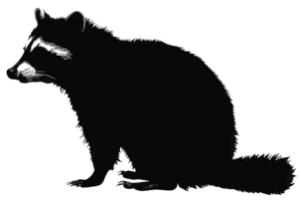Raccoon Removal: When to DIY-it, and When to Call the Professionals
Raccoons are one of the most intelligent, adaptable, and versatile animals that most people will ever encounter. Because they are so charming and intelligent, they can appear to be quite friendly to humans. This, however, makes them dangerous- especially for children and other domesticated animals. Raccoons frequently move in around spaces commonly used and occupied by humans. They can become accustomed to eating our food waste, which often puts them into close contact with people.
Perhaps what makes them most dangerous is the fact that they are susceptible to rabies, which they can easily contract from other animals that are native to their relative environments- such as squirrels. Rabies infected raccoons can be extremely dangerous. When these animals become aggressive, their speed, dexterity, and frightfully sharp teeth and claws make them highly formidable assailants. This is why it is so important to engage with professional raccoon removal services if you are experiencing a raccoon presence in or around your home.
Trapping Raccoons: Methods and Dangers
If you choose to trap a raccoon yourself, there are a number of considerations that you must take into account. To begin, trapping these animals may be illegal in your town, county, or region. Wildlife protection laws and statutes may be in place to protect a given location or a larger area. Sometimes the boundaries between protected areas and non-protected areas may not be clear. Taking raccoon removal into your own hands always comes with the responsibility of knowing and understanding the pertinent laws and regulations.
Second, as mentioned above, raccoons are highly intelligent, wild animals that frequently carry diseases. These diseases can make them hostile and unpredictable. Even if you have become familiar with a given animal, or family of animals- it can be easy to mistake a dangerous raccoon for one that has learned to trust you. Also, even raccoons that you have developed a mutual familiarity with can become rabid and turn on you unexpectedly.
This means that even if you successfully trap a raccoon, it is possible for the animal to defeat the trap mechanism, escape, and pose a threat. If you have small children on the property where raccoons are present, frankly, the risk of removing them yourself or ignoring them may be an unacceptable risk.
Live Cage Traps
It is understandable that you may not want to kill a raccoon, in which case a cage might be a reasonable option. Live cages are a common way to capture and remove raccoons. There are one door and two-door traps. The bait used will be positioned according to the type of trap you use.
These traps draw the animal in using food as bait. Once the animal is inside, the cage can be transported safely. Few animals are capable of escaping these traps. Raccoons, however, can occasionally use their superior manual dexterity and intelligence to escape. These instances are rare- but they are possible, making transporting a captured raccoon in an enclosed vehicle cabin particularly risky.
If you choose to kill captured raccoons, using traps to catch them first can be effective. You need to keep in mind that it may be required by law to dispose of diseased animals in a specific way- or to have certain licensing to do so. Traps will be most effective when placed properly in areas with the most raccoon traffic. Traps should be anchored to the ground, as the captured raccoon may try to tip it over once captured. Finally, it should be expected that some domestic animals, especially cats and small dogs may enter the trap and become captured.
Lethal Traps
Traps that kill the animals they capture are an option- especially if you are concerned about the threat raccoons can pose to children or and domestic animals. Lethal traps mostly come in the form of the “bear trap” style snapping trap. These come with certain risks that should be noted.
The primary risk factor of deadly animal traps is of course the chance that children, animals, or any unintended target may fall victim to the trap. For this reason, they should never be placed in areas where animals and small children may encounter them. Flag markers can be used to indicate the trap for anyone mature enough to recognize the marker. It is also possible to set up a temporary enclosure that most animals will not be able to get through- but will not be a barrier to raccoons.
Call on the Professionals
Now that we have discussed most of the risks and rewards associated with removing raccoons on your own, it should be clear that hiring a professional raccoon trapper comes with several distinct advantages.
Chief among these advantages is the fact that a professional will be properly licensed, insured, and will understand all of the safety and legal implications of catching raccoons. A professional will also have all of the proper equipment and access to proper and sanitary disposal facilities. Also they will know where dead animals can be disposed of. They will have access to lands and partners who can help relocate the animal if possible.
To learn more about your raccoon removal options, get in touch with the pros today. Our friendly pest removal experts are eager to answer your questions.





















